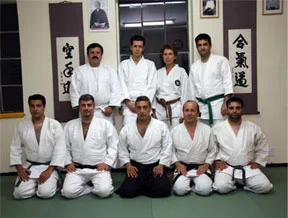 When we bow or observe special moments or ceremonies, we do so for the purpose of training our minds and to complement the training of our bodies.
When we bow or observe special moments or ceremonies, we do so for the purpose of training our minds and to complement the training of our bodies.
In karate, aikido and other martial arts, we bow often. We bow when we enter a dojo and leave a dojo, when we step onto or off the mats, when we meet other students or instructors, when class begins and ends, and when we begin training with our partner.
We bow to remind ourselves to be grateful. We are grateful to those who developed the Aikido we study, which is why we bow to the pictures of O-sensei. We are grateful to have a place to study and people with whom to study. We bow to thank our instructor and fellow students.
When entering or leaving a dojo, it is customary to face the front of the practice area and bow. We use this to remind ourselves to be grateful for the place we train in and the art we practice.
Upon entering the dojo, one should take off hats and shoes, dispose of chewing gum, and stop any distracting practices that may interfere with training. One should endeavor to focus all one's attention and energy on the study of Aikido.
At the dojo, one should change from street clothes to a training uniform called a dogi (or comfortable training clothes such as a sweat suit, if a dogi is not available). This helps shed outside concerns and focus attention on the task at hand - Aikido training. Clean and complete uniforms are preferred since a completeness of dress reflects the attention one gives to the study of Aikido. In addition, a complete uniform affords greater protection, for example during breakfalls or techniques that involve grabbing the clothing.
When greeting a fellow student or an instructor, one may do so with a traditional bow. This is customary in the practice of Japanese Budo. Bowing is also a sign of respect.
When stepping on or stepping off the practice mat, one should bow to the front of the dojo. This expresses one's intent to concentrate fully on Aikido training and acts as a respectful recognition of all the individuals, past and present, who have contributed to Aikido.
Being on time for class demonstrates a respect for the valuable time given by the teachers and ones fellow students to the practice of this art. If you must arrive late, please wait by the side of the mats until invited by the sensei and when it is safe to do so, warm yourself up on a corner of the mats. The sensei will then incorporate you into an appopriate group.
All jewelry and watches must be removed before practice to avoid damage. All finger and toe-nails should be trimmed so as not to cause injury to others or oneself. Those with long hair are strongly urged to have it well tied back.
When class is ready to begin, students line up in seiza (kneeling position) in a straight line and in ascending order of rank. The senior student will call "Shomen ni rei" (bow to the front), followed by, "Sensei ni rei" (bow to the instructor). This routine should also take place at the end of class.
One should sit in seiza when a technique is being taught. This position keeps legs tucked safely under the body to avoid fellow students tripping or falling on them. Training should begin and end with a polite bow between partners. When corrected by the instructor, bow and say either "osu" or thank you. If one needs to leave the mat or practice area during class, one should inform the instructor.
Shouting, cursing or displays of anger are not tolerated on the mat. Any disagreements should be calmly discussed by the participants, and if need be, brought to the instructor or a senior student.
Once the class is dismissed by the instructor, students bow to each other and thank each other for the training.